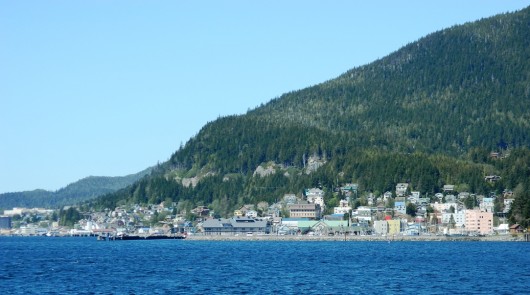The Ketchikan City Council on Thursday approved a $31,000 contract with consulting firm CH2MHill to continue studying the coliform problem at Ketchikan Lakes, the city’s source of tap water. But, one Council member asked management to also compile information about what it would take to get a filtration plant.
For years, Ketchikan Lakes tested fine for coliform. But in 2011, there was a sudden spike, and the levels haven’t gone down. A big problem with that is, the federal Environmental Protection Agency has strict rules about coliform. If the city can’t get the levels down, it’s going to be forced to filter.
The city isn’t worried about its ability to treat water that has high levels of coliform; it’s what happens if the system fails. And that’s something Ketchikan has a little experience with.
Here is Water Division Manager John Kleinegger, speaking to the Council: “Back in 1984, you remember, when you went out to the Carlanna Area, it was about the color of weak tea, and the disinfection process there was not really sufficient and there were over 200 people that were sick.”
That incident prompted the city to stop using Carlanna Lake as a water source.
Council Member Bob Sivertsen noted that the city has a known problem with its water at Ketchikan Lakes, and is moving forward with the study in order to see what could be done to fix it.
“But, having seen all this going forward, one of the things I would like to see at some point is for our management, our water division, over the next couple of months, to look at what filtration would look like for us,” he said.
City Manager Karl Amylon said he can do that.
Amylon also talked about the city’s new chloramine treatment system, which he stressed is unrelated to the coliform issue.
The city recently started using chloramine – a mixture of chlorine and ammonia – to treat its water in order to reduce levels of EPA-regulated byproducts. Those byproducts form when chlorine comes in contact with organic material.
Amylon said the first test results are in. The byproducts now are below the thresholds, but it’s close. Too close. As the weather warms up, he said the levels likely will rise, so they’ve come up with a plan that they hope will keep the numbers down.
“We’re gonna reduce the amount of chlorine on the front end and make it up on the back end,” he said. “By doing that, it’s less time for the chlorine to react with the organics. We put it back it … at approximately the area of chloramination. That could drop us down even more than where we are now.”
Also during the meeting, the Council deferred a motion to use $183,000 worth of reserves to help pay for increased employee health insurance costs. Council members asked Amylon to come back with suggested budget cuts instead of dipping into reserves.
Amylon warned that they might not like his suggestions.
“I can recommend a series of cuts, but I know going into that exercise that those cuts are probably not going to be endorsed by the Council because I’ve recommended them in the past and the Council has not signed off,” he said.
Council Member DeAnn Karlson said, maybe he could provide more options than in the past for the Council to consider.
The Council also deferred action on a compensation plan that would increase salary costs to the city. It will come back to the Council during budget time in the fall.
During Council comments at the end of the meeting, Council Member Matt Olsen suggested that the city place an item on the next city-borough cooperative relations committee meeting agenda that would offer ballot initiatives transferring library, solid waste, museum, civic center and harbor powers to the borough.
Olsen’s proposal was prompted by a recent controversy over borough funding for the city-run library.
Amylon clarified what transferring those powers could mean.
“If you’re asking the borough to assume those powers on an areawide basis, all of the assets as well as the liability would go,” he explained. “So in the case of the library, it would be the debt; in the case of solid waste, it would be solid waste reserves that would go with them. Same with the harbors.”
Olsen’s suggestion received the support of four Council members, so it will go to the committee for discussion.









